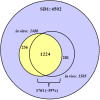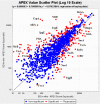In vivo versus in vitro protein abundance analysis of Shigella dysenteriae type 1 reveals changes in the expression of proteins involved in virulence, stress and energy metabolism
- PMID: 21702961
- PMCID: PMC3136414
- DOI: 10.1186/1471-2180-11-147
In vivo versus in vitro protein abundance analysis of Shigella dysenteriae type 1 reveals changes in the expression of proteins involved in virulence, stress and energy metabolism
Abstract
Background: Shigella dysenteriae serotype 1 (SD1) causes the most severe form of epidemic bacillary dysentery. Quantitative proteome profiling of Shigella dysenteriae serotype 1 (SD1) in vitro (derived from LB cell cultures) and in vivo (derived from gnotobiotic piglets) was performed by 2D-LC-MS/MS and APEX, a label-free computationally modified spectral counting methodology.
Results: Overall, 1761 proteins were quantitated at a 5% FDR (false discovery rate), including 1480 and 1505 from in vitro and in vivo samples, respectively. Identification of 350 cytoplasmic membrane and outer membrane (OM) proteins (38% of in silico predicted SD1 membrane proteome) contributed to the most extensive survey of the Shigella membrane proteome reported so far. Differential protein abundance analysis using statistical tests revealed that SD1 cells switched to an anaerobic energy metabolism under in vivo conditions, resulting in an increase in fermentative, propanoate, butanoate and nitrate metabolism. Abundance increases of transcription activators FNR and Nar supported the notion of a switch from aerobic to anaerobic respiration in the host gut environment. High in vivo abundances of proteins involved in acid resistance (GadB, AdiA) and mixed acid fermentation (PflA/PflB) indicated bacterial survival responses to acid stress, while increased abundance of oxidative stress proteins (YfiD/YfiF/SodB) implied that defense mechanisms against oxygen radicals were mobilized. Proteins involved in peptidoglycan turnover (MurB) were increased, while β-barrel OM proteins (OmpA), OM lipoproteins (NlpD), chaperones involved in OM protein folding pathways (YraP, NlpB) and lipopolysaccharide biosynthesis (Imp) were decreased, suggesting unexpected modulations of the outer membrane/peptidoglycan layers in vivo. Several virulence proteins of the Mxi-Spa type III secretion system and invasion plasmid antigens (Ipa proteins) required for invasion of colonic epithelial cells, and release of bacteria into the host cell cytosol were increased in vivo.
Conclusions: Global proteomic profiling of SD1 comparing in vivo vs. in vitro proteomes revealed differential expression of proteins geared towards survival of the pathogen in the host gut environment, including increased abundance of proteins involved in anaerobic energy respiration, acid resistance and virulence. The immunogenic OspC2, OspC3 and IpgA virulence proteins were detected solely under in vivo conditions, lending credence to their candidacy as potential vaccine targets.
Figures





Similar articles
-
The Shigella dysenteriae serotype 1 proteome, profiled in the host intestinal environment, reveals major metabolic modifications and increased expression of invasive proteins.Proteomics. 2009 Nov;9(22):5029-45. doi: 10.1002/pmic.200900196. Proteomics. 2009. PMID: 19813213 Free PMC article.
-
Regulation of OmpA Translation and Shigella dysenteriae Virulence by an RNA Thermometer.Infect Immun. 2020 Feb 20;88(3):e00871-19. doi: 10.1128/IAI.00871-19. Print 2020 Feb 20. Infect Immun. 2020. PMID: 31792074 Free PMC article.
-
Proteomes of pathogenic Escherichia coli/Shigella group surveyed in their host environments.Expert Rev Proteomics. 2014 Oct;11(5):593-609. doi: 10.1586/14789450.2014.935342. Epub 2014 Aug 28. Expert Rev Proteomics. 2014. PMID: 25163594 Review.
-
Comparison of two label-free global quantitation methods, APEX and 2D gel electrophoresis, applied to the Shigella dysenteriae proteome.Proteome Sci. 2009 Jun 29;7:22. doi: 10.1186/1477-5956-7-22. Proteome Sci. 2009. PMID: 19563668 Free PMC article.
-
The roles of the virulence factor IpaB in Shigella spp. in the escape from immune cells and invasion of epithelial cells.Microbiol Res. 2015 Dec;181:43-51. doi: 10.1016/j.micres.2015.08.006. Epub 2015 Sep 2. Microbiol Res. 2015. PMID: 26640051 Review.
Cited by
-
Identification of common highly expressed genes of Salmonella Enteritidis by in silico prediction of gene expression and in vitro transcriptomic analysis.Poult Sci. 2019 Jul 1;98(7):2948-2963. doi: 10.3382/ps/pez119. Poult Sci. 2019. PMID: 30953073 Free PMC article.
-
Analysis of the proteome of intracellular Shigella flexneri reveals pathways important for intracellular growth.Infect Immun. 2013 Dec;81(12):4635-48. doi: 10.1128/IAI.00975-13. Epub 2013 Oct 7. Infect Immun. 2013. PMID: 24101689 Free PMC article.
-
Proteomic View of Interactions of Shiga Toxin-Producing Escherichia coli with the Intestinal Environment in Gnotobiotic Piglets.PLoS One. 2013 Jun 19;8(6):e66462. doi: 10.1371/journal.pone.0066462. Print 2013. PLoS One. 2013. PMID: 23840478 Free PMC article.
-
Transcriptional regulation of bacterial virulence gene expression by molecular oxygen and nitric oxide.Virulence. 2014;5(8):794-809. doi: 10.4161/viru.27794. Epub 2014 Oct 31. Virulence. 2014. PMID: 25603427 Free PMC article. Review.
-
The identification of novel immunogenic antigens as potential Shigella vaccine components.Genome Med. 2021 Jan 15;13(1):8. doi: 10.1186/s13073-020-00824-4. Genome Med. 2021. PMID: 33451348 Free PMC article.
References
-
- Niyogi SK. Shigellosis. J Microbiol. 2005;43(2):133–143. - PubMed
Publication types
MeSH terms
Substances
Grants and funding
LinkOut - more resources
Full Text Sources
Other Literature Sources
Miscellaneous

